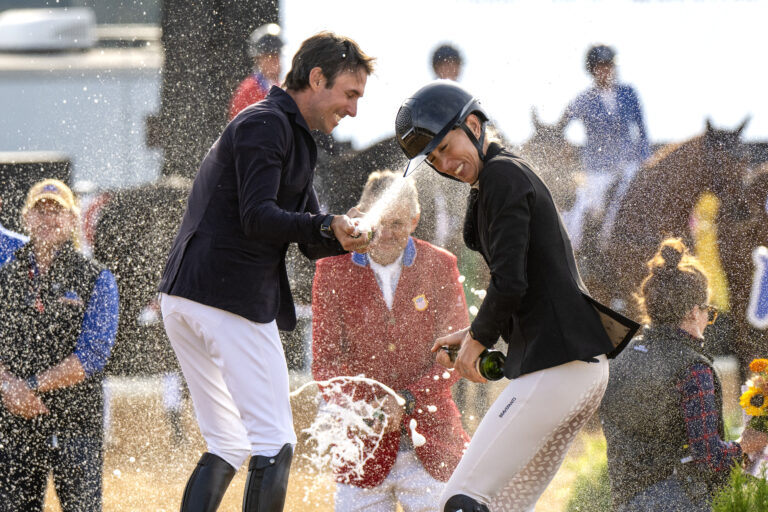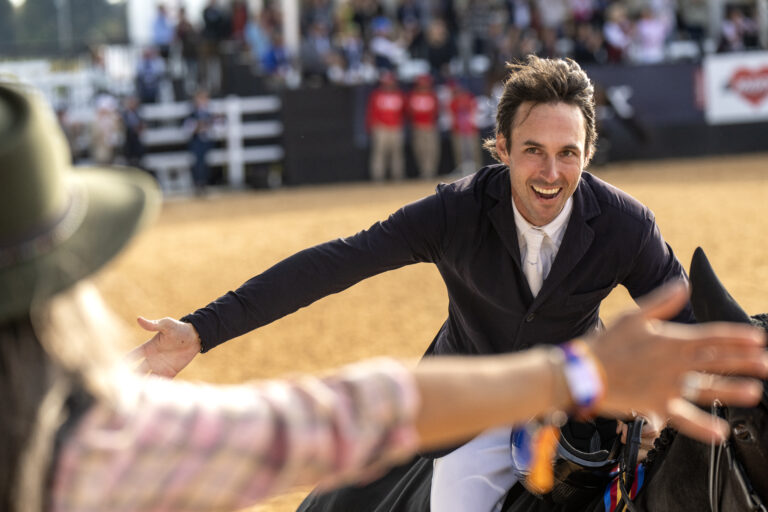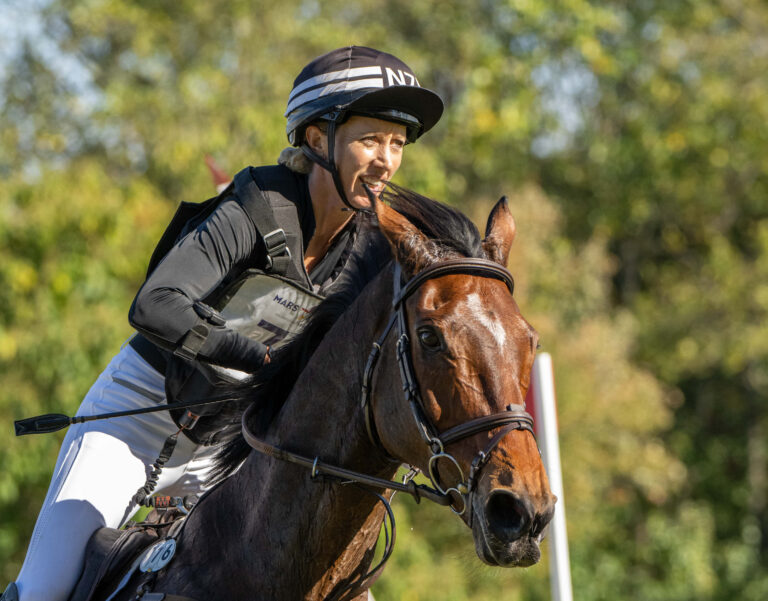Just as the days are beginning to grow longer and you’re anticipating more time to ride, you notice that your normally sweet mare is becoming increasingly cranky. She’s difficult under saddle and her pinned-back ears warn you to back off. From time to time, she stomps her feet and squeals for no apparent reason. You consider whether she’s ill or injured, but know that there’s a much more likely cause of all the fuss: She’s in heat and exhibiting some of the typical mare-ish behavior associated with an increase in the activity of her reproductive system.

It helps to know that it’s just a matter of time before she cycles back to normal. But you wonder what you might do to ease her through the hormonal swings that can cause physical discomfort as well as fuel undesirable behavior. Several medical treatments and supplements may offer relief. Plus, experienced professionals point to the benefits of conscientious management to take at least some of the stress out of estrus. To determine the course of action that’s right for your mare and you, it’s worthwhile to first understand what’s going on inside her.
The Biological Basics
Female mammals of many species have a reproductive cycle that includes a recurring period of sexual receptivity (estrus). For horses the natural breeding season occurs in the spring and summer. During this time, mares ovulate every 21 days and are in estrus for five to seven days. In the winter months they experience a period of sexual inactivity (anestrus).

“Normal cyclicity in mares is dependent on the onset of longer day lengths,” says Charles Love, DVM, PhD, Dip ACT, professor of equine theriogenology at Texas A&M University. Specifically, the increase in daylight that is a hallmark of spring signals the pituitary gland at the base of the mare’s brain to release what is known as follicle-stimulating hormone into the bloodstream. FSH travels to the ovaries, where it initiates the development of a cavity, or follicle, containing an egg (ovum). As the follicle grows on an ovary, it produces the hormone estrogen. At a certain point, the level of estrogen in the blood signals the pituitary gland to secrete a second hormone. This one, luteinizing hormone, triggers ovulation, causing the follicle to rupture and send the egg into a fallopian tube, the passageway where it may be fertilized as it makes its way to the uterus.
Once its contents are released, the follicle forms a temporary structure called the corpus luteum. It functions for approximately 12 to 14 days, secreting some estrogen and relatively high levels of the hormone progesterone to sustain pregnancy. In those instances where conception does not occur, the hormone prostaglandin—which is released by the uterine wall—causes the corpus luteum to be reabsorbed into the ovary. In turn, the level of progesterone decreases and the estrus cycle resumes. If, however, the mare conceives, the activity of the growing embryo in the uterus halts the release of prostaglandin. As a result, the corpus luteum remains functional and progesterone levels are maintained so that the pregnancy continues.

“When the mare ovulates she will remain in heat one to two days after and then will go out of heat,” Dr. Love explains. During that time she may display a variety of signs—usually when she’s around other horses, especially males—to indicate she’s receptive to a stallion. They include lifting her tail, squatting, urinating and “winking”—opening and closing the lower part of the vulva, the outside portion of her genital tract.
Beyond the behaviors that signal she’s ready to breed, a mare in heat may also exhibit some degree of change in attitude and performance—but not all mares do. The most common behaviors are tail swishing, squealing and kicking as well as excessive urination. In addition, physical discomfort from the pain of a developing follicle may cause a mare to be uncooperative and hard to ride or train, leading to decreased performance under saddle.
“Most mares are difficult in heat due to the constant urination and the distraction of being around other horses,” Dr. Love says. “Some mares do exhibit ovarian pain and may actually colic as a result.”
For these reasons and others, it’s natural for a concerned owner to turn to the offerings of modern medicine in search of a remedy to ease the ill effects of estrus.
A Measure of Control
A variety of medications, supplements and procedures are available to suppress or eliminate estrus, ensuring little to no change in a mare’s temperament and behavior throughout the year as well as consistency in performance during training and competition. None of the treatments that follow should be used without first consulting a veterinarian to evaluate merits and potential drawbacks for each individual mare. Here are several of the most common options.
Altrenogest (Regu-Mate) is an FDA-approved progestin (synthetic progesterone) prescribed by a veterinarian. It is administered orally—either in feed or put directly on a mare’s tongue using a syringe—on a daily basis at a cost of approximately $23 per dose. It increases the level of progesterone in the blood and blocks ovulation, keeping a mare out of heat for as long as the medication is administered. Altrenogest is readily absorbed through skin so it must be handled with care so that it does not affect the person dispensing it. It carries the warning to always wear gloves when handling the drug and not allow it to contact eyes, skin or clothes. Because it can be harmful to their own cycles, premenopausal and pregnant women are advised to exercise extreme caution when handling altrenogest.
Medroxyprogesterone acetate (MPA, Depo-Provera) is a synthetic derivative of the hormone progesterone and is used to suppress ovulation in women. It is not FDA-approved for use in horses. However, a veterinarian may prescribe the drug to reduce a mare’s estrus symptoms. Studies show that MPA, which is administered by injection, does not keep a mare from entering heat, but anecdotal evidence indicates that it improves behavior (see sidebar “What Role in Competition?”). Little is known about its long-term effects.
Dried raspberry leaf, according to anecdotal evidence, has been shown to reduce estrus symptoms when it’s provided as a daily supplement in feed. Long used by women to assist in maintaining a healthy pregnancy, the herbal remedy—which is not subject to the scrutiny of any regulatory agency—contains antioxidants and nutrients believed to relax muscle spasms and strengthen uterine tone. Raspberry leaf will not stop a mare from entering heat, but its effects may relieve the symptoms that lead to moodiness.
Intrauterine marbles are reported to suppress estrus in some mares. Within 24 hours after ovulation, a veterinarian places a single sterilized glass marble in the uterus. At approximately 35 millimeters in size (just less than an inch), the marble tricks the body into thinking it is an embryo, which causes the uterine lining to alter its secretion of prostaglandin to maintain pregnancy. The success rate of using an intrauterine marble varies, but it is a relatively inexpensive option. Depending on the cost of the vet’s farm call and the marble, the total may reach a couple hundred dollars for an implantation that lasts six months to a year. The mare returns to a normal cycle when the marble is removed. Long-term use (beyond a year) is not recommended because it can invite complications, including uterine infection and inflammation of the uterine lining. It’s also possible for the marble or pieces of it to become embedded in the uterine lining. What’s more, a mare may expel the marble without her owner’s knowledge.
Spaying (ovariectomy) may be recommended in cases where intense ovarian pain cannot be relieved. The ovaries are surgically removed in a hospital setting with the mare under standing sedation. The procedure is expensive and carries some risk, such as hemorrhage and infection. In addition, although the mare will be permanently unable to conceive, she still may experience hormone-related behavior issues since estrogen is produced from sources other than ovaries, such as the adrenal glands.
“There are anecdotal reports of improvement following ovariectomy.” says Dr. Love, adding a caution: “Remember, once the ovaries are removed you can’t put them back. The owner should also realize once ovaries are removed the mare may exhibit signs of heat to some degree continuously, which is an unintended consequence.”
Dr. Love offers guidance for deciding the best course for a mare who seems to be adversely affected by estrus: “Too often the hormones of the mare and her cycle are blamed for poor performance,” Dr. Love says. He recommends determining “whether the mare performs well when out of heat. If so, that suggests that the problem is really heat-related.” However, “If the mare does not improve [when she no longer is in season], then other sources of discomfort should be investigated, such as ovarian pain, ulcer, musculoskeletal pain and rider inexperience. Mares will also show signs of heat [frequent urination, for instance] as a result of stress.”
A Focus on Behavior
In managing mares—or any horse, for that matter—John Michael Durr, a professional eventer and hunter/jumper rider, takes the approach that knowing them is key to doing right by them. With horses regularly coming and going from his training and sales barn in Shelby, North Carolina, he has handled a number of mares and developed his own successful strategy for dealing with them. The emphasis of his approach, he says, is to maintain a consistent training and management routine that allows him to really get to know the mares in his care so he can more readily identify when something isn’t right and determine the best way to resolve any issues.

“Keeping mares on a consistent routine will keep their stress levels down and make it more likely that you notice even a slight change in health or behavior,” Durr says. For instance, “I keep a close eye on fit and competing mares for signs of [gastrointestinal] ulcers and treat them if necessary. I also make sure they have well-fitting tack because they might be more sensitive to an uncomfortable saddle or bridle than a gelding will be.”
As a general practice, Durr won’t give a mare medication to control her cycle unless there are pronounced inconsistencies in her behavior on the ground and under saddle. As an example, he describes his experience with Esprit de la Danse (aka Dani) a Canadian Sport Horse mare he successfully evented at the three-star level. She grew so attached to her barn buddies when she was in season that she would pace and whinny for them instead of eat. As a result, she lost weight. Plus, she was constantly distracted, making it difficult to maintain consistency in her training program. After a thorough physical examination, the mare’s veterinarian prescribed OvaMed, an FDA-approved generic alternative to Regu-Mate, which was effective in reducing her attachment issues and stress levels during estrus.

“She was still a sensitive mare,” says Durr, but the medication helped to re-establish consistency in her behavior and allowed him to create what he describes as “a quantifiable system” for knowing how to plan for and prevent her disruptive episodes of fretfulness. He goes on to explain his approach: “I really try to give mares several breaks a year from any medications they are on to suppress their cycles. To me it’s important that they still get to have a healthy cycle. So when they are letting down from events, they come off the meds.”
What remains constant is Durr’s attention to their behavior and doing what he sees as necessary to keep them on an even keel. He notes that when traveling he is especially careful to set up a comfortable home away from home to reduce stress and increase the likelihood that a mare will get adequate rest so she’s ready for the rigors of competition. “Traveling is hard on mares,” he says. “We make all these accommodations for stallions when shipping, but the same factors have to be considered for mares.”

As a result, he won’t put a mare next to a stallion on a trailer, especially if she’s in season. He also avoids shipping a mare next to her best friend and refrains from putting them in adjacent stalls at competitions to lessen the possibility of attachment drama. In addition, he takes steps to minimize distractions at the front of a mare’s stall, doing what he can to reduce foot traffic and providing access to plenty of hay to keep her occupied.
A Tale of Two Sisters
Like Durr, Roslyn Johnson, an eventing horse breeder in Grantville, Georgia, has learned that there is no one-size-fits-all solution when it comes to managing a mare’s heat cycle. Each is an individual and is best treated as such. She offers her experience with two of her homebred mares as an example.
Full sisters Flo, age 14, and Kite, age 12, are seven-eighths Thoroughbred and one-eighth Irish Sport Horse. As youngsters they were both started under saddle by the same person and developed under the same training program. Each has evented through the Intermediate level. The only notable difference in their upbringing, Johnson says, is how Flo was handled as a foal. As the farm’s first homebred, Flo was spoiled and “mare-ish from the get-go,” she admits. In contrast, Kite’s upbringing was more disciplined, Johnson says, and she “is one of the sweetest mares you’ll ever meet. She has a good work ethic and is very consistent.”
Kite was never any trouble, even when in estrus, until one day at a competition. She was 7 at the time and started exhibiting cranky, opinionated behavior, which was totally uncharacteristic for her. She was refusing all over the place and dumped [her rider]. The vets at the show checked her out to make sure there weren’t any lameness issues.
Kite was pronounced sound, but her atypical behavior still concerned Johnson. So she trailered the mare to Auburn University’s John Thomas Vaughan Large Animal Teaching Hospital in Auburn, Alabama. A physical exam there included an ultrasound that revealed an enormous follicle in one of Kite’s ovaries that very likely was painful and the reason for her unusual behavior.
Ever since the episode, Kite has received Regu-Mate during the competition season with good results. Her sister Flo is on a regimen of the medication, too, because it was discovered that she also is prone to oversized follicles. Johnson reports that Flo’s behavior has improved as a result.
Though the sisters’ issues were resolved with medication, Johnson stresses, as medical experts do, the importance of a comprehensive veterinary evaluation to determine whether estrus—or something else—is at the heart of mare-ish behavior. Another upper-level event mare that Johnson owns seemed to experience physical discomfort during her cycle and, as a result, began receiving Regu-Mate. But unexpectedly, her ill temper worsened. So the treatment was discontinued and the mare’s behavior monitored. When she failed to improve, a veterinary exam revealed that she was suffering from a compensatory strain in her back. She was treated for her injury and has had no need for hormonal medication during her cycle.
The episode underscores the value of a truly objective approach to dealing with mares and with estrus. Knowing your mare when she’s in season and when she’s not will provide you with the best framework for evaluating the need for medical intervention when she’s in heat and out of sorts. It will also serve as a guide for making changes in how you care for and manage her and reflect your concern that any action you take is with her well-being in mind.
What Role in Competition?
There is some debate within the equestrian community on whether the two major substances commonly used to control estrus in mares and, in certain cases, the behavior of stallions and geldings have a place in competition. Some owners, riders and trainers say that using altrenogest and medroxyprogesterone acetate (MPA)—especially in stallions to manage potentially injurious behavior—creates a safer environment for all. Others believe the drugs are a more humane alternative to methods such as excessive longeing to quiet a horse before an athletic performance. But a number of other drugs that have a calming effect already are prohibited in competition. Where do the major organizations that regulate equine sports stand on altrenogest and MPA?

The International Equestrian Federation (FEI) prohibits the use of altrenogest in male horses and MPA in all horses during competition. US Equestrian (USEF) currently allows altrenogest to be used in mares during competition, but as of December 1, 2024, the use of any progestogens in stallions and geldings is now prohibited.
The organization began discussing regulation of these substances during its annual meeting in January 2017. In addition, in March of that year during a USEF public workshop, Patrick McCue, DVM, PhD, Dip ACT, a professor of theriogenology based at the Equine Reproduction Laboratory of Colorado State University, discussed the results of a study on the use of altrenogest and MPA in mares (“Efficacy of Medroxyprogesterone Acetate in Suppression of Estrus in Cycling Mares” by Erica K. Gee, BVSc, PhD, Dip ACT; Catherine DeLuca, DVM; Jessica L. Stylski, BS and Patrick M. McCue, DVM, PhD, Dip ACT).
The findings showed that those treated with altrenogest did not come into heat. In contrast, mares treated with MPA exhibited an increase in luteinizing hormone, developed follicles and ovulated. But so did mares who received a saline placebo, leading researchers to conclude that MPA does not have a biological effect on a mare’s estrus cycle and any improvement in behavior must come from some other effect of the drug.
With the findings in mind, US Equestrian concluded that more information was needed before a decision could be made. At its mid-year meeting in 2017, the Board of Directors approved a recommendation by its USEF MPA Panel to continue researching and analyzing the use of the drug in competition horses. The panel included trainer/judge Geoff Teall, USEF Vice President Elisabeth Goth, 2016 Olympian Laura Graves and Veterinary Committee Chair Kent Allen, DVM.

To support the ongoing research effort into MPA, a disclosure form became required for all horses—mares, stallions and geldings—receiving the medication within three months of a competition start date. The form tracked the dates when MPA was administered as well as the dosage.
This data, combined with an additional investigation by the MPA Panel, led to a December 1, 2019 ruling by the US Equestrian Board of Directors to prohibit the use of MPA in all horses competing in USEF-licensed competitions. According to US Equestrian, the MPA Panel determined MPA has no therapeutic use in competition horses, as it does not interrupt estrus in mares. Additionally, MPA is not approved by the United States Food and Drug Administration (FDA) for use in equines, and its use has been reported and documented to be associated with several cases of anaphylaxis and fatality. As a result of this analysis, the Panel voted unanimously to recommend MPA be added to the list of USEF prohibited substances.
“In 2017, we debated the use of this substance and its efficacy, but now, with numerous fatalities associated with the use of MPA, this decision became clear: MPA must be banned,” said USEF President Murray Kessler. “The information clearly supports the prohibition of this substance, and I am proud of the decision of the Board of Directors. USEF has a responsibility to ensure the welfare of our horses, and the loss of one horse resulting from the use of a non-therapeutic substance such as MPA is one too many.”
This article was originally published in the April 2018 issue of Practical Horseman, but has been updated according to new information published by US Equestrian.








